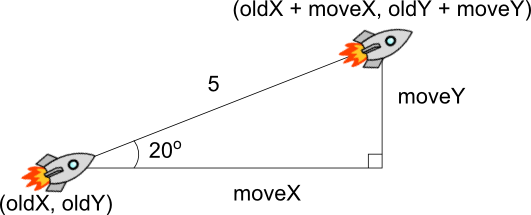I was absolutely sold by Neil Brown’s (@twistedsq) passion for Greenfoot. I knew I would not be able to recreate that passion in a blog post myself, so I asked Neil if he would consider contributing a guest post himself. I was absolutely thrilled when he agreed. A email conversation ensued, format and content agreed, I am pleased to introduce Greenfoot, courtesy of Neil Brown himself.
Introducing The Sinepost
My memory of being taught maths at school is of learning a technique and repeatedly applying it to lots of tiny, pure problems. Pure maths is an apt term: devoid of application and untainted by a relation to anything outside the bounds of the textbook. Other students would offer the classic cry: “Sir, what’s this useful for? Why are we learning this?” I think they were probably frowned upon at the time as lacking diligence, but they were right. Without practical application, students find material less motivating and harder to understand.
I don’t think I ever asked what maths was useful for. This was firstly because I loved it, but secondly because I *was* applying it. The classic nerdy bedroom programmer, I spent much of my teen years playing and creating games. I needed my spaceship to move at angle: that needs sine and cosine. My two asteroids were colliding: model them as circles and use Pythagoras to compare the distance to the sum of the two radiuses. Newtonian mechanics as the backdrop of my asteroids clone. Manipulating number representations to speed up my line-drawing algorithm for the ray-gun.
Now, my day job is developing a programming environment specifically aimed at teenage beginners to programming: Greenfoot. And still the same problems seem to occur in maths: What’s it useful for? So I began to try and write down all the uses I know for maths (well, geometry and mechanics at least) within the creation of computer games. It’s in a blog called the sinepost. You can use this list of posts to start at the beginning: http://sinepost.wordpress.com/sorted-posts/
The idea behind the blog is to provide engaging examples of maths being applied. I think the idea is especially strong when the problem is real (at least in some domain) and maths is a necessary part of the solution: There is no way to move a spaceship in a game at an angle without using trigonometry. To see if a bullet has hit an asteroid (modelled as a circle), you must use Pythagoras. The basics of geometry are used over and over again in games.
While the blog focuses on explaining the use of the techniques, I believe there is scope to then construct examples for the students to
tackle. Examples where maths is no longer used in a microcosm, on a small artificial problem. Instead, students can tackle larger problems which involve several steps, and solving problems where the path has not been mapped out for them. Move this mouse five pixels towards that cheese (one answer: arctangent, then sine and cosine). Now make the mouse circle the cheese (answer: add ninety degrees after arctangent). Then change the mouse so that it can only notice the cheese from a certain distance (answer: Pythagoras). Now make it only notice the cheese when it has direct line of sight (answer: intersection of line and circle). There are lots of game-based tasks that can be used to get students to apply maths in a context where maths really is necessary.
In the next post, Neil will be looking at the advantages and disadvantages of applying maths in computing to raise attainment.
Neil Brown (@twistedsq) is a Computing education researcher at University of Kent (UK), doing development and outreach for Greenfoot/BlueJ educational IDEs.
[qr_code_display]

